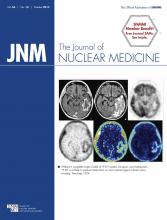Abstract
Early prognostic stratification is desirable in patients with suspected atypical parkinsonian syndromes (APSs) for optimal treatment and counseling. We investigated the prognostic value of imaging disease-specific metabolism patterns with 18F-FDG PET compared with that of clinical diagnosis. Methods: Seventy-eight patients with suspected APS at study inclusion underwent a follow-up of up to 5.9 y after prospective 18F-FDG PET imaging. Survival data were analyzed by Kaplan–Meier and Cox regression analyses according to diagnostic classifications provided by 18F-FDG PET at baseline and clinical diagnoses after a median follow-up of 1 y after PET. Results: Forty-four of 78 patients were alive 4.7 ± 0.6 y after PET. Patients diagnosed with an APS by PET or 1-y clinical follow-up showed a significantly shorter median survival time (4.1 y, age-adjusted hazard ratios [HRs] = 3.8 for both classifiers) than those diagnosed with Lewy-body diseases (LBDs; majority Parkinson disease [PD]; median survival time not reached). Subgroup classifications of progressive supranuclear palsy/corticobasal degeneration (PSP/CBD) or multiple-system atrophy (MSA) by PET and clinical follow-up were associated with significantly shorter survival than PD. Age-adjusted mortality was significantly increased for PSP/CBD (HR = 5.2) and MSA (HR = 5.6) classified by PET, but for PSP/CBD only when diagnosed by clinical follow-up (HR = 4.5). Patients with a PET pattern suggestive of PD with dementia/dementia with Lewy bodies (PDD/DLB) exhibited a trend toward shorter survival than those with PD (P = 0.07), whereas patients classified as PDD/DLB by clinical follow-up did not (P = 0.65). Conclusion: 18F-FDG PET is an early predictor of survival in patients with clinically suspected APS. Detection of cortical or subcortical hypometabolism by 18F-FDG PET is an unfavorable predictor. Risk stratification by 18F-FDG PET appears to be at least as predictive as the 1-y follow-up clinical diagnosis. This finding strongly supports the early inclusion of PET imaging in patient care.
Footnotes
Published online Jul. 30, 2015.
- © 2015 by the Society of Nuclear Medicine and Molecular Imaging, Inc.







